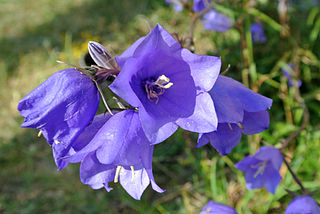
Campanula is one of several genera of flowering plants in the family Campanulaceae commonly known as bellflowers. They take both their common and scientific names from the bell-shaped flowers — campanula is Latin for "little bell".

Campanula rotundifolia, the harebell, Scottish bluebell, or bluebell of Scotland, is a species of flowering plant in the bellflower family Campanulaceae. This herbaceous perennial is found throughout the temperate regions of the northern hemisphere. In Scotland, it is often known simply as bluebell. It is the floral emblem of Sweden where it is known as small bluebell. It produces its violet-blue, bell-shaped flowers in late summer and autumn.
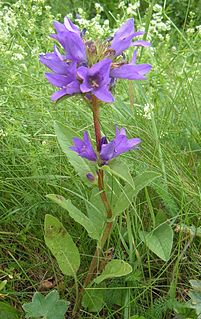
Campanula glomerata, known by the common names clustered bellflower or Dane's blood, is a species of flowering plant in the genus Campanula, belonging to the family Campanulaceae. It is the county flower of Rutland, England.
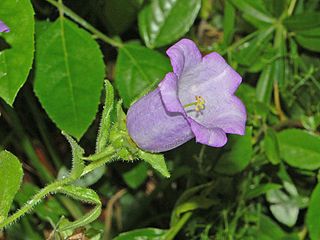
Campanula medium, common name Canterbury bells, is an annual or biennial flowering plant of the genus Campanula, belonging to the family Campanulaceae. In floriography, it represents gratitude, or faith and constancy.
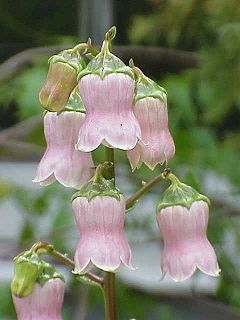
Azorina is a monotypic genus of flowering plants within the family Campanulaceae, whose sole species, Azorina vidalii, the Azores Bellflower, is endemic to the Azores. Its fragmented population is made up of fewer than 1000 mature plants limited to the coastlines of several of the islands. It is also the only species in this family native to the Azores.
Paracalyx balfourii is a species of legume in the family Fabaceae. It is found only in Yemen. Its natural habitats are subtropical or tropical dry forests and rocky areas.
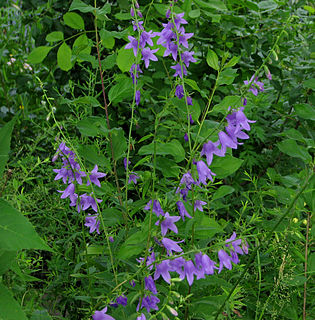
Campanula rapunculoides, known by the common names creeping bellflower, or rampion bellflower, is a perennial herbaceous plant of the genus Campanula, belonging to the family Campanulaceae. In some parts of North America, it is an extremely invasive species.
Helichrysum balfourii is a species of flowering plant in the family Asteraceae. It is found only in Yemen. Its natural habitat is subtropical or tropical dry forests.
Hypericum balfourii is a species of flowering plant in the family Hypericaceae. It is endemic to Socotra, an island archipelago that is part of Yemen. It grows in mountain shrubland dominated by Cephalocroton. It is usually found on granite terrain above 600 meters in elevation.

Hypericum socotranum is a species of flowering plant in the Hypericaceae family which is endemic to the island of Socotra in Yemen. Its natural habitats are subtropical or tropical dry forests and rocky areas.

Hypericum tortuosum is a species of flowering plant in the genus Hypericum. It is found only in Socotra, Yemen, where it is endemic. The species is an apomorphic relative of the other Socotran species in Hypericum sect. Triadenioides and is most closely related to Hypericum scopulorum. Its natural habitats are subtropical or tropical dry forests and subtropical or tropical dry shrubland.

Eureiandra balfourii is a species of plant in the family Cucurbitaceae. It is endemic to Yemen. Its natural habitat is subtropical or tropical dry forests.
Heliotropium balfourii is a species of plant in the family Boraginaceae. It is endemic to Yemen. Its natural habitats are subtropical or tropical dry forests and subtropical or tropical dry shrubland.
Oldenlandia balfourii is a species of plant in the family Rubiaceae. It is endemic to Yemen. Its natural habitat is subtropical or tropical dry forests.

Pandanus balfourii, also known as Vakwa bordmer, is a species of plant in the family Pandanaceae, one of four Pandanus species that are endemic to the Seychelles.
Polycarpaea balfourii is a species of plant in the family Caryophyllaceae. It is endemic to Yemen. Its natural habitats are subtropical or tropical dry shrubland and rocky areas.

Campanula rapunculus, common name rampion bellflower, rampion, rover bellflower, or rapunzel, is a species of bellflower (Campanula) in the family Campanulaceae.

Campanula gelida is a stenoendemic, critically endangered species of flowering plant in the bellflower family Campanulaceae. It is a perennial species that grows in the mountains of Hrubý Jeseník in the Czech Republic. It evolved through specialization of an isolated population of Campanula scheuchzeri, an Alpine species, which expanded to the area of the Sudetes during a colder period, probably the last ice age. It is closely related to Campanula bohemica, endemic to the Krkonoše Mountains. Sometimes it is even considered its subspecies and referred to as Campanula bohemica subsp. gelida. They all belong to the group of related species Campanula rotundifolia agg.
Begonia samhaensis is a species in the family Begoniaceae. Similar to Begonia socotrana but separated by the asymmetrically ovate leaves and the unequal tepals in the male flowers; outer tepals broadly orbicular, 1.5–2.2 × 1.7–2.5 cm; inner obovate elliptic, 1.4–2.0 × 0.8 × 1.4 cm.
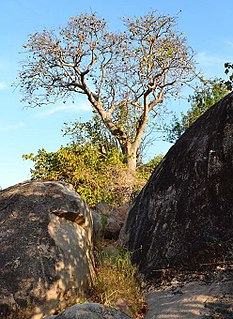
Sterculia africana is a deciduous tree, belonging to the genus Sterculia and the family Malvaceae. The species is sometimes called the "mopopaja tree". It is distributed throughout Northeast Africa to Arabia.













